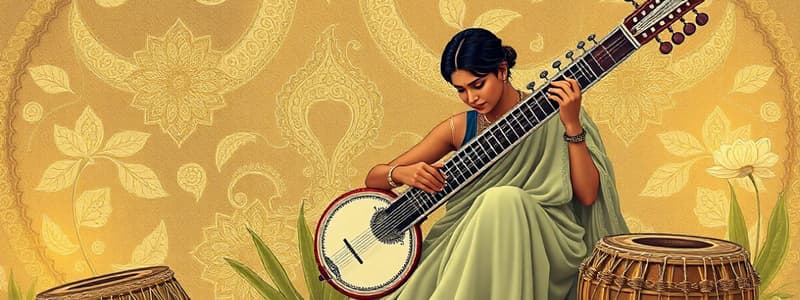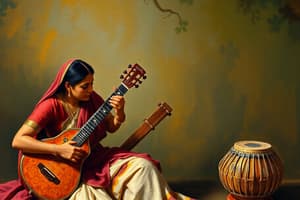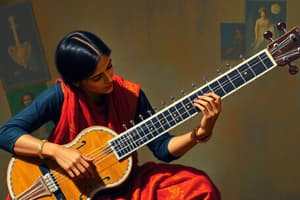Podcast
Questions and Answers
Which of the following is NOT a core element of Indian classical music structure?
Which of the following is NOT a core element of Indian classical music structure?
What is the function of the black spot on the Tabla's drumheads?
What is the function of the black spot on the Tabla's drumheads?
Which material is commonly used for the Dayan (right drum) of the Tabla?
Which material is commonly used for the Dayan (right drum) of the Tabla?
What is the role of the Tamboura in Indian classical music?
What is the role of the Tamboura in Indian classical music?
Signup and view all the answers
How is Indian classical music transmitted through generations?
How is Indian classical music transmitted through generations?
Signup and view all the answers
Flashcards
Raga
Raga
A single melody line in Indian classical music.
Drone
Drone
A constant, fixed note that supports the raga.
Tala
Tala
The rhythm or beat in Indian classical music.
Tabla
Tabla
Signup and view all the flashcards
Sitar
Sitar
Signup and view all the flashcards
Study Notes
Indian Classical Music
- Indian classical music has been passed down for over 3,000 years.
- Despite regional variations, music pieces generally share common elements.
- Key components include raga (melody), drone (constant note), and tala (rhythm).
- Common instruments include sitar, tabla, and tambura.
Sitar and Tabla
- The sitar is a stringed instrument.
- The tabla is a pair of drums (right - dayan, left - bayan).
- Tabla drumheads are made of goat or cow hide and sometimes contain metal and flour fillings
- Often one drum is made of wood and the other metal.
- The tabla produces a bell-like sound when struck.
- The tabla plays a cycle of beats throughout a musical piece.
Studying That Suits You
Use AI to generate personalized quizzes and flashcards to suit your learning preferences.
Description
Explore the rich traditions of Indian classical music that have evolved over millennia. This quiz covers essential concepts, including raga, tala, and the unique characteristics of the sitar and tabla. Test your knowledge of these integral instruments and their roles in Indian music.




